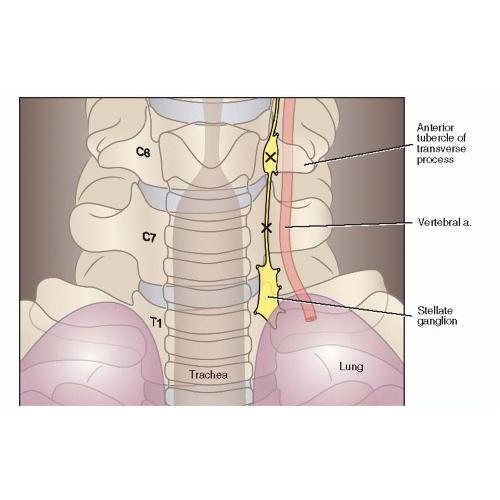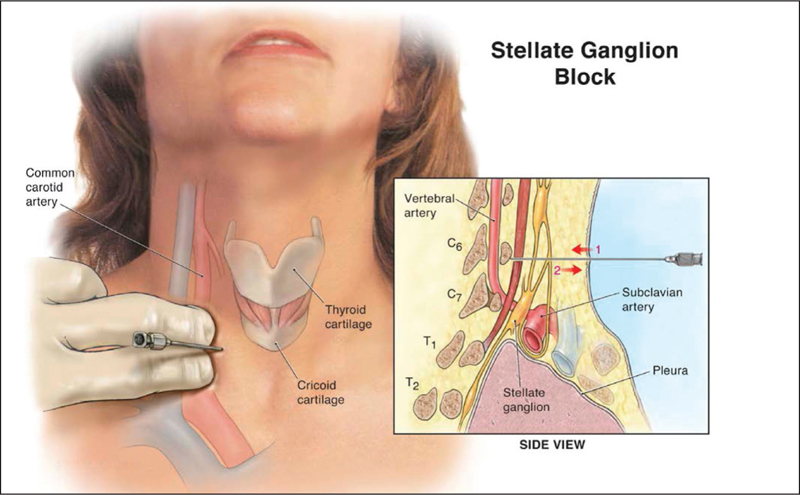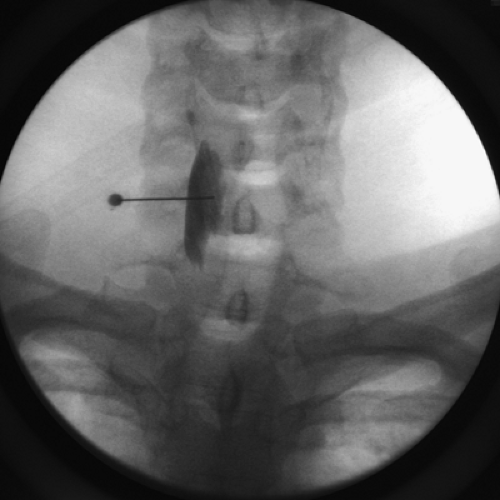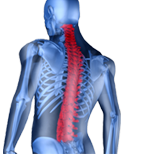Stellate Ganglion Block

The Stellate Ganglion Block is an injection procedure used to block or decrease pain located in the head, neck, chest, or arm. It also helps increase circulation. The stellate ganglion is a group of nerves located in the upper neck and is part of the sympathetic nervous system. After an injury or illness, the sympathetic nervous system may not function properly, causing pain. Some of the more common conditions are: complex regional pain syndrome (CRPS) also known as reflex sympathetic dystrophy (RSD), causalgia (nerve injury), and herpes zoster (shingles) of the head and face. The stellate ganglion block is also used to treat intractable angina (severe pain caused by heart disease). If this treatment relieves your pain, the doctor will perform a series of blocks at another time in an attempt to break the pain cycle and provide long lasting pain relief. The number of blocks you will need depends on how long the pain relief lasted between injections. Usually you will get more and longer pain relief after each injection.

Procedure Overview:
The Stellate Ganglion Block is an outpatient procedure, usually done in the Operating Room or a Special Procedure Room. For your safety and comfort, you will be connected to monitoring equipment (EKG monitor, blood pressure cuff, and a blood-oxygen monitoring device). The doctor or nurse may start an intravenous line and give some medicine to help you relax. You will also have skin temperature monitors placed on your hands. The procedure is performed with you lying on your back. A rolled-up sheet or other support is placed between your shoulder blades, which may be a little uncomfortable. After cleansing your neck with an antiseptic solution, the doctor will inject numbing medicine into the skin and tissue. This may cause a burning sensation for a few seconds.
The doctor will also apply some pressure on your neck to determine exactly where to place the needle. It is very important that you do not talk, swallow, or cough. If you have to swallow or cough, raise your hand to let someone know. After the numbing medicine takes effect the doctor will insert another needle, and with the assistance of a special X-ray machine called a fluoroscope, inject a radiopaque dye (contrast solution) to confirm correct needle position. When satisfied with the needle position, the doctor will inject a small mixture of numbing medicine (anesthetic) and anti-inflammatory medicine (cortisone/steroid). Although it takes about 10 to 20 minutes for the medication to take effect, you will remain at the Clinic until the doctor feels you are ready to leave.

Procedure Details:
Will you be asleep for the procedure? It is not necessary for you to go to sleep for this procedure; however, you will receive enough medication to keep you comfortable. How long will the procedure take? Normally, a stellate ganglion block procedure takes no more than 30 minutes.
Before the procedure:
Since you will be receiving medication, it is recommended that you do not eat within eight hours before the procedure. If you are a diabetic, be sure to discuss your eating and medication schedule with the doctor. You may need to stop taking certain medications several days before the procedure. Please remind the doctor of all prescription and over-the-counter medications you take, including herbal and vitamin supplements. The doctor will tell you if and when you need to discontinue the medications. It is very important to tell the doctor if you have asthma, had an allergic reaction (i.e. hives, itchiness, difficulty breathing, any treatment which required hospitalization) to the injected dye for a previous radiology exam (CT scan, angiogram, etc) or if you have had an allergic reaction to shellfish (shrimp, scallops, lobster, crab). The doctor may prescribe some medications for you to take before having the procedure. Tell the doctor if you develop a cold, fever, or flu symptoms before your scheduled appointment.
After the procedure:
You need to be aware of several potential side effects. These side effects, which usually disappear four to eight hours after the block may include: A droopy eyelid on the side of the block; Redness and blurred vision in the eye on the side of the block; A feeling like a lump in your throat; Difficulty swallowing; Hoarseness of your voice; Warmth and weakness of the arm on the side of the block. Drink plenty of clear liquids after the procedure to help remove the dye from the kidneys and do not eat solid food until you are comfortable swallowing. Do not drive for the remainder of the day. Please have an adult drive you home or accompany you in a taxi or other public transportation. Depending on how you feel, you may resume normal activities and return to work the following day. If the doctor prescribes physical therapy, it is very important that you continue with the physical therapy program. Although you may feel much better immediately after the injection (due to the numbing medicine), there is a possibility your pain may return within a few hours. It may take a few days for the steroid medication to start working.
Procedure Risks:
The risks, although infrequent, include: Collapsed lung; Numbness of an arm that may last for hours; Temporary weakness or numbness from the neck down; Allergic reaction to the medication; Nerve damage; Bruising at the injection site; Infection at the injection site; Injection of medication into a blood vessel. If you experience new shortness of breath 24 - 48 hours after the injection or any signs of infection in the area of the injection you should call the doctor right away.



